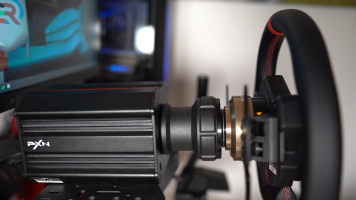With Direct Drive wheelbases being affordable even at the entry level now, Michel takes a look at a particularly interesting bundle in his PXN-V12 Lite Review.
It was not long ago that Direct Drive was unimaginably expensive for most sim racers. The last few years have changed that, though. Fanatec started the foray into affordable DD bases with the CSL DD in 2021, and since then, numerous manufacturers have launched their own hardware options.
PXN is one of them. The Chinese manufacturer may not be that well known in the western hemisphere, but they are aiming to change that. Presences at the Gamescom and SimRacing Expo in 2023 showed their range of hardware, which ranges from entry-level sets to full rigs, as well as a 16 Nm DD base called V15.
For the entry level, PXN offers the V12 Lite bundle that comes with the base, the PD-HM pedals, and the W DS Racing Wheel. The bundle should be of particular interest to sim racers due to its price of about €550/$550 – and its compatibility.
PXN-V12 Lite Review: Compatibility
Indeed, the base is not only compatible with PC and Xbox Series X|S and Xbox One, but also with PlayStation 4 and PlayStation 5. The latter is achieved via a dongle that plugs into the back of the wheelbase.This makes the PXN-V12 Lite bundle a terrific option for console sim racers or those that switch platforms frequently. Meanwhile, the PXN Wheel app available for iOS and Android lets users change the settings of the base. That means you do not need to have a PC handy to plug it into to adjust it.
Features
The wheel itself looks solid and is 300mm in diameter. Quality is good for the price, although the red stitching around the synthetic leather could have been done a bit cleaner in some places. Meanwhile, the wheel has both shifter paddles and dual clutch paddles on board by default – something not many in that price category offer.Other features include an aluminum quick release similar to that of MOZA Racing or Simagic, an RGB shift light stripe and two rotary switches. The buttons, however, feel slightly wobbly and do not offer much resistance – whch does not prevent them from performing as intended.
PXN-V12 Lite Review: Wheelbase
As mentioned, the PXN-12 Lite wheelbase puts out a maximum of 6Nm of torque. It weighs just under 5 kilograms (10,8 pounds) and comes with four mounting holes at the bottom. A bracket kit lets you mount it to your desk.As for the FFB performance, the PXN-V12 Lite performs well. Michel tested the base in Assetto Corsa, Assetto Corsa Competizione, iRacing, DiRT Rally 2.0, EA Sports WRC and Gran Turismo 7 on PS5. Check out the video for his impressions!
Pedals
How about the PD-HM pedals, though? The bundle comes with three of them, but you do not have to use all of them. You can adjust their position on the included mounting plate, and the angle and height can also be changed.However, as has to be expected at the price point, the PD-HM set is relatively basic. The brake pedal can be adjusted with different springs and elastomers, which are not included, though. Instead of a load cell, the pedals use magnetic HALL effect sensors.
PXN-V12 Lite Review: Software
Unfortunately, the PXN software does not share the solid impression of the hardware. Michel’s PXN-V12 Lite review mentions unsigned Windows drivers, instructions that are lacking a bit, a bug when setting up the pedals and missing translations do not help the user experience. Luckily, this has nothing to do with the build quality of the bundle. Software improvements can usually be achieved much more quickly.Verdict
The quality of the hardware is solid, as Michel’s PXN-V12 Lite review shows. For the price, the bundle is definitely an option for beginners to consider. This is especially true if you want to get into Direct Drive without breaking the bank. The expanded compatibility is another plus.Similarly, the adjustability of the pedals is helpful so sim racers can adapt the set to their liking. Tuning options for the brake pedal are not included, but can be purchased separately. Meanwhile, the PXN Wheel app allows customization of wheelbase and pedal settings from your smartphone.
The V12 Lite’s FFB output is solid for a 6Nm base, and can be very smooth, depending on the title. However, there are some issues with the set, too. The user experience could use an upgrade when it comes to the software. Translations and signatures for Windows drivers are at the top of the list there. Additonally, warranty claims could potentially be difficult with hardware imported from China.
What are your impressions of the bundle after our PXN-V12 Lite Review? Let us know on Twitter @OverTake_gg or in the comments below!

